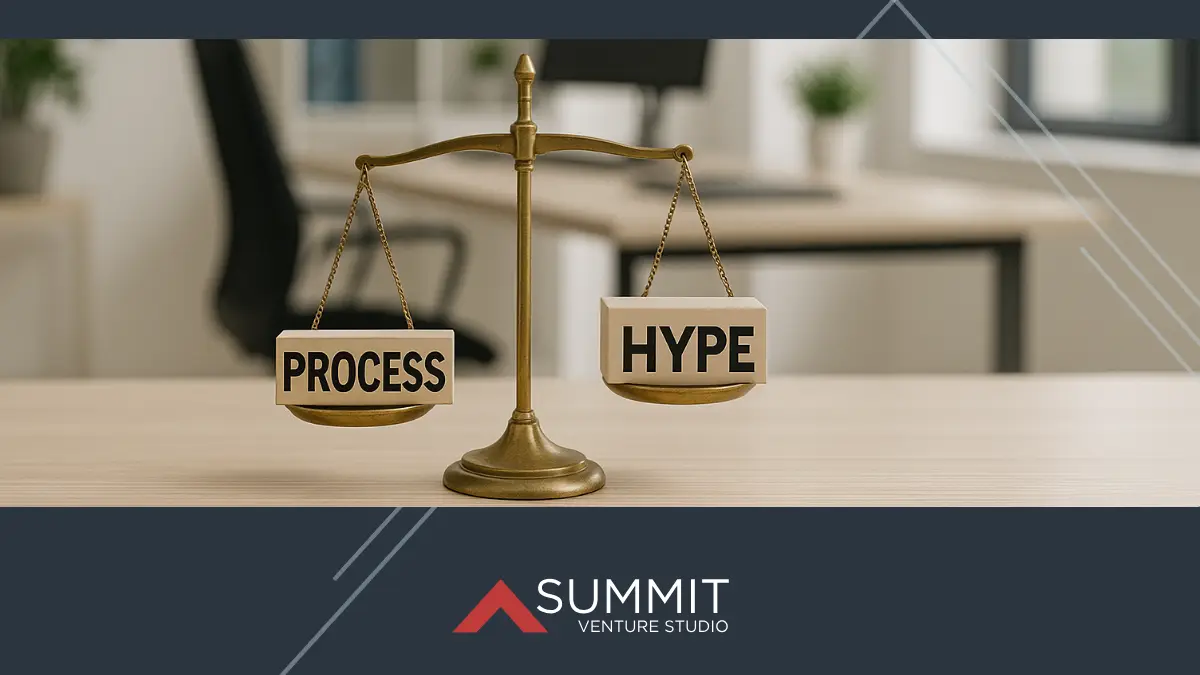Authored by Crisman Armenta, Account Manager at Summit Venture Studio, this post shares 8 lessons drawn from his work analyzing university tech transfer opportunities and his study of crypto trading. The two worlds of startup evaluation and trading both show that process, not hype, separates lasting success from costly mistakes.
You have a business idea. Maybe three. But how do you know if any of them are worth your time, money, and energy?
We’ve reviewed thousands of ideas, technologies, and disclosures at Summit Venture Studio, and only a handful ever move forward. Meanwhile, in trading, only a fraction of setups are worth committing to. Both fields demand the same discipline: a process that filters out noise and keeps you from chasing hype.
These eight lessons, drawn from venture studio work and trading practice, show how process-driven decision-making can guide you to the best startup idea worth building.
How to choose the best startup idea starts with process, not hype. By validating assumptions, zooming out to assess markets, and testing small before committing big, founders can avoid costly mistakes and focus on opportunities with real potential.
1. Stack Proof Before You Bet Big
One “green candle” doesn’t make a trade. And one “That’s cool” comment doesn’t validate a business. At SVS, we ask: What must be true? This frames every assumption you need to prove from different angles: the problem is real, people care about solving it, and they will put money down.
Your Move: Just like Canva’s founder Melanie Perkins validated by talking to teachers and professionals, you should interview 10-15 people in your target audience to confirm repeated patterns and pain points.
2. Zoom Out Before You Dive In
On a short chart, a setup looks perfect until you zoom out and see it’s headed straight into resistance. Likewise, a shiny tech or feature means little if the market is overcrowded or shrinking.
Your Move: Check Crunchbase for funding trends in your space, scan Exploding Topics for emerging trends, and review LinkedIn job postings to measure market direction. Is the industry hiring or slowing down?
3. Be Ready to Walk Away
Some setups’ risks just aren’t worth the reward. Likewise, an idea that eats resources without strong upside should stay on the whiteboard.
Your Move: Amazon shut down Dash Buttons when adoption stalled. You should also define your “win” upfront and walk away if the timeline or budget isn’t met.
4. Decide Your Stop Loss Before You Start
Traders set stop losses before they enter. Founders must do the same by deciding the maximum time, money, and energy they’ll invest before pivoting or quitting.
Your Move: Instagram’s founders pivoted from Burbn, a check-in app, to photo sharing once they saw it was the real traction driver. Set your pivot threshold (like 500 active users in 3 months or we focus on the feature driving engagement.)
5. Wait for Real Confirmation
A breakout is not real until the candle closes with volume behind. Your idea is not ready for launch until you see traction you can measure.
Your Move: Dropbox validated with a demo video, not a full product. Use a 2-3 minute Loom video or clickable Figma prototype to test demand in your audience community before building.
6. Learn From Your Own History
Traders back test. Founders track decisions, experiments, and results.
Your Move: Buffer grew into a multi-million dollar SaaS in part because they documented every test and shared it publicly. Keep an “idea journal” logging each test and its results. You’ll spot patterns that shape smarter decisions.
7. Respect Your Process
Your process exists to save you from yourself. Skipping the process becomes a bad habit. SVS filters disclosures through gates in determining which software IP is worth the investment:
Market pain check – Is the problem big enough that solving it matters?
Competitive scan – Who else is already solving the problem, and how are they positioned?
Technology readiness – Is the opportunity an MVP we can demo, or just an idea on paper? The closer it is to being usable, the faster and cheaper we can validate it.
Early traction signals – Is there any data, usage, or stakeholder interest we can point to right now?
Your Move: Define your own go/no-go gates and stick to them, like Y Combinator’s problem-market-team filter.
8. Protect Your Downside
Unsure? Trade small. For startups, test small.
Your Move: Zappos took pictures of shoes from local stores and sold them online before holding inventory. Find the smallest test that yields real customer behavior data.
“Your process exists to save you from yourself.”
-Crisman Armenta
Recap
Whether a chart in trading or a software IP startup opportunity, the winners are the ones that go through a clear, repeatable process. The process keeps you in check, removes emotion, and forces a structured plan.
Startup founders and traders face the same challenge of making decisions in uncertainty. The winners don’t chase hype. They stick to a process. Discipline is not optional.
Would your idea make the cut?
If you’d like to see what we’re working on at SVS or explore opportunities to collaborate, get in touch with us by submitting the Work With Us form.
FAQ
The best way to choose a startup idea is to validate assumptions with real users, confirm market demand, and use a repeatable process to filter out hype.
Start with small, cheap tests (interviews, surveys, demo videos, or prototypes) to gather measurable traction before committing major resources.
Process removes emotional bias and ensures founders commit only when evidence supports market demand and growth potential.
Trading emphasizes discipline, risk management, and confirmation. These principles help founders know when to pivot, cut losses, or double down.
Relying on friends’ opinions, ignoring market signals, building before validating, and failing to set clear stop-loss limits.

